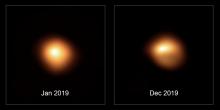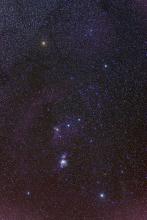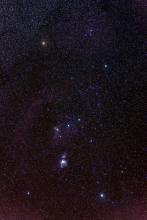Listen to today's episode of StarDate on the web the same day it airs in high-quality streaming audio without any extra ads or announcements. Choose a $8 one-month pass, or listen every day for a year for just $30.
You are here
Giant Cannibal
Given the chance, a star can easily become a cannibal — a bigger star can swallow a smaller one. The star that gets eaten can leave its mark on the surviving star, though. Among other things, it can trigger an eruption or change the way the star rotates.
An example of that just may be found in Betelgeuse, the bright orange shoulder of Orion. It’s high in the south-southwest as night falls, above the hunter’s three-star belt.
When Betelgeuse was young, it was probably a few dozen times the diameter of the Sun. As it aged, though, changes in its core caused its outer layers to puff outward. Today, it’s many hundreds of times the Sun’s diameter.
And as Betelgeuse expanded, it just might have swallowed a companion star. That’s the conclusion reached by University of Texas astronomer Craig Wheeler after a team of his students used a computer model to study how Betelgeuse spins on its axis.
Wheeler says its rotation rate is unusually fast for a star of its size. The computer model shows that the star would spin that fast if it swallowed a Sun-sized companion. As the star spiraled in, it transferred its orbital motion to Betelgeuse’s outer layers, making the star spin faster.
A shell of gas surrounds Betelgeuse. It could have been expelled from the star when it swallowed the companion. Judging from the size and motion of the shell, that would have happened about a hundred thousand years ago — when Betelgeuse might have become a cannibal.
Script by Damond Benningfield






